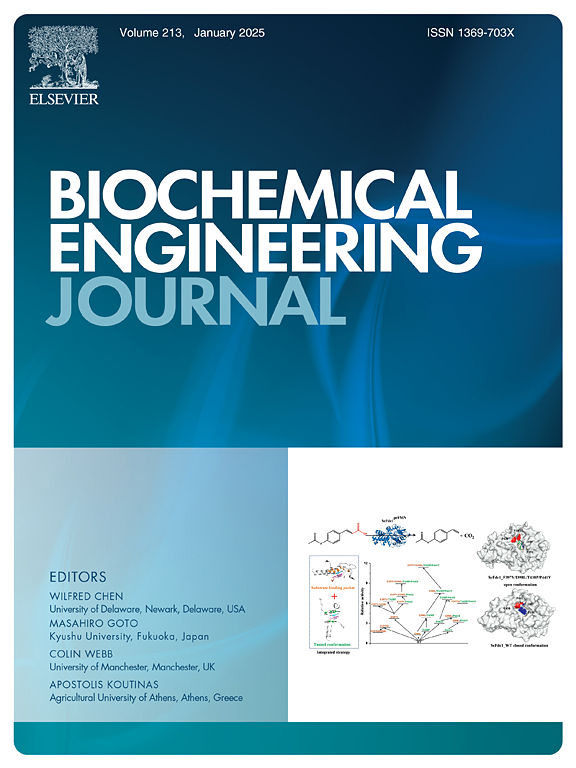滴流床生物CO转化的建模与仿真及与CSTR的比较
IF 3.7
3区 生物学
Q2 BIOTECHNOLOGY & APPLIED MICROBIOLOGY
引用次数: 0
摘要
混合微生物群落在滴流床反应器(TBR)中的合成气生物甲烷化已达到技术成熟度4-5级。扩大TBR需要研究在传质或生长动力学成为限速步骤的操作条件。当前工作的新颖之处在于其首创的模型开发,可以模拟微生物生长和生物膜形成以及TBR的水力和传质行为。重点是羧基营养型氢,它将CO生物转化为CO2和H2,降低气相CO水平。模型验证表明,对不同体积和高径比的TBR具有较好的预测能力。比较了5000 ml(填充床)半中试规模TBR、220 ml(填充床)实验室规模TBR和5000 ml(液量)CSTR的CO转化效率。考虑悬浮生长,由于体积传质系数更高,半中试规模TBR的性能优于实验室规模TBR和CSTR。当考虑生物膜生长时,半中试和实验室规模的tbr的CO转化效率分别提高了1.03倍和4倍。值得注意的是,具有生物膜生长的实验室规模TBR超过了工作体积高22倍的CSTR。由于微生物细胞质量从0.081 g增加到0.29 g,实验室规模TBR的CO转化效率从23.3% %(悬浮生长)增加到86.3 %(生物膜生长)。最后,在不同液体再循环速率和恒定气体流速下,TBR的模拟结果显示,液体雷诺数为35时,传质限制转变为微生物生长限制。本文章由计算机程序翻译,如有差异,请以英文原文为准。
Modeling and simulation of biological CO conversion in trickle bed reactor and comparison with CSTR
Syngas biomethanation in a trickle bed reactor (TBR) by mixed microbial consortia has reached a technology readiness level of 4–5. Scaling up the TBR requires investigating the operating conditions under which mass transfer or growth kinetics becomes the rate-limiting step. The novelty of the current work is the first-of-its-kind model development that can simulate microbial growth and biofilm formation together with the hydraulic and mass transfer behavior of TBR. The focus is on carboxydotrophic hydrogenogens, which biologically convert CO to CO2 and H2, reducing gas phase CO levels. Model validation showed excellent predictive capacity for TBR of different volumes and height-to-diameter ratios. CO conversion efficiency was compared between 5000 ml (packed bed) semi-pilot-scale TBR, 220 ml (packed bed) lab-scale TBR, and 5000 ml (liquid volume) CSTR. Considering suspended growth, the semi-pilot-scale TBR outperformed the lab-scale TBR and CSTR due to a higher volumetric mass transfer coefficient. When biofilm growth was considered for the TBRs, CO conversion efficiency increased 1.03 times and 4 times for the semi-pilot- and lab-scale TBRs, respectively. Notably, the lab-scale TBR, with biofilm growth, surpassed the 22 times higher working volume CSTR. CO conversion efficiency in the lab-scale TBR increased from 23.3 % (suspended growth) to 86.3 % (biofilm growth) due to an increase of microbial cell mass from 0.081 to 0.29 g cells. Finally, simulations at varying liquid recirculation rates and constant gas flow rates for the TBR revealed a threshold at a liquid Reynolds number 35, where mass transfer limitations shift to microbial growth limitations.
求助全文
通过发布文献求助,成功后即可免费获取论文全文。
去求助
来源期刊

Biochemical Engineering Journal
工程技术-工程:化工
CiteScore
7.10
自引率
5.10%
发文量
380
审稿时长
34 days
期刊介绍:
The Biochemical Engineering Journal aims to promote progress in the crucial chemical engineering aspects of the development of biological processes associated with everything from raw materials preparation to product recovery relevant to industries as diverse as medical/healthcare, industrial biotechnology, and environmental biotechnology.
The Journal welcomes full length original research papers, short communications, and review papers* in the following research fields:
Biocatalysis (enzyme or microbial) and biotransformations, including immobilized biocatalyst preparation and kinetics
Biosensors and Biodevices including biofabrication and novel fuel cell development
Bioseparations including scale-up and protein refolding/renaturation
Environmental Bioengineering including bioconversion, bioremediation, and microbial fuel cells
Bioreactor Systems including characterization, optimization and scale-up
Bioresources and Biorefinery Engineering including biomass conversion, biofuels, bioenergy, and optimization
Industrial Biotechnology including specialty chemicals, platform chemicals and neutraceuticals
Biomaterials and Tissue Engineering including bioartificial organs, cell encapsulation, and controlled release
Cell Culture Engineering (plant, animal or insect cells) including viral vectors, monoclonal antibodies, recombinant proteins, vaccines, and secondary metabolites
Cell Therapies and Stem Cells including pluripotent, mesenchymal and hematopoietic stem cells; immunotherapies; tissue-specific differentiation; and cryopreservation
Metabolic Engineering, Systems and Synthetic Biology including OMICS, bioinformatics, in silico biology, and metabolic flux analysis
Protein Engineering including enzyme engineering and directed evolution.
 求助内容:
求助内容: 应助结果提醒方式:
应助结果提醒方式:


